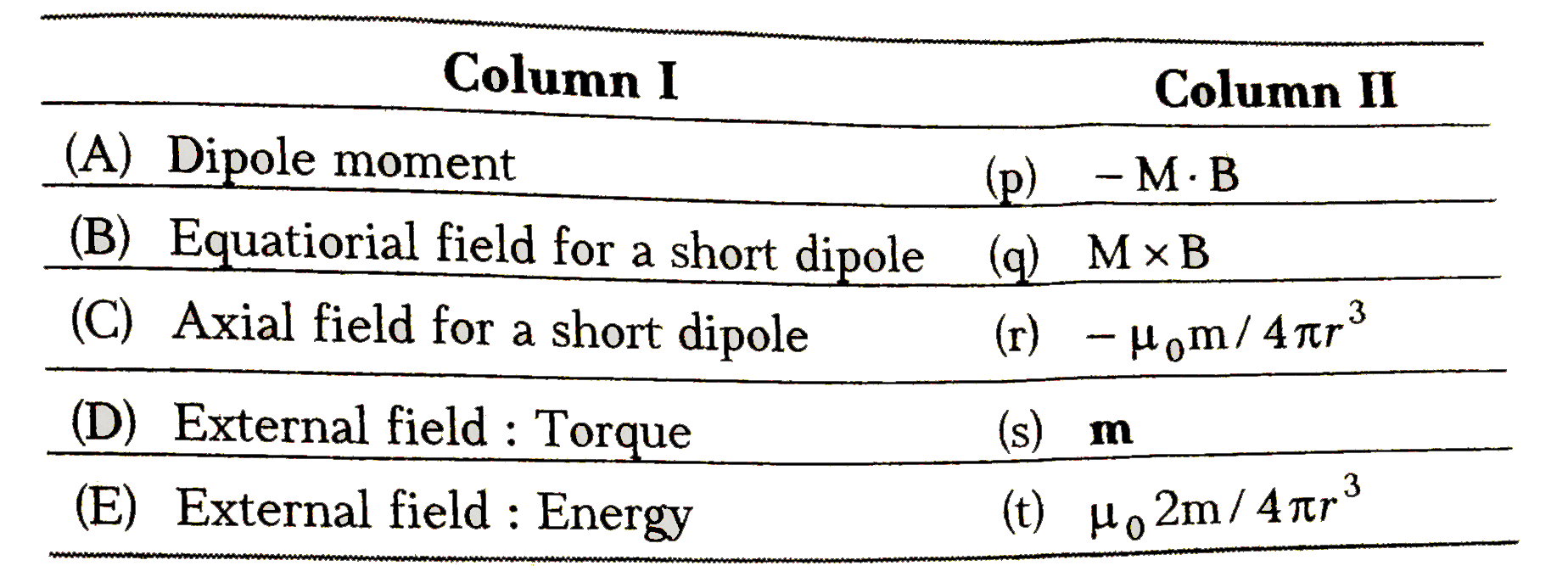A: A magnetic dipole experiences maximum torque when it is placed normal to the magnetic field.
R: The minimum potential energy of magnetic dipole is zero.
If both Assertion & Reason are true and the reason is the correct explanation of the assertion then mark (1)
If both Assertion & Reason are true but the reason is not the correct explanation of the assertion, then mark 2.
If assertion is true statement but Reason is false, then mark (3)
If both Assertion and Reason are false statements, then mark (4)
The correct Answer is:C
To solve the assertion and reason question, we will analyze both statements step by step.
Step 1: Analyze the Assertion
The assertion states: "A magnetic dipole experiences maximum torque when it is placed normal to the magnetic field."
- The torque (τ) experienced by a magnetic dipole in a magnetic field is given by the formula:
τ=m×B=mBsinθ
where:
- m is the magnetic dipole moment,
- B is the magnetic field,
- θ is the angle between m and B.
- For torque to be maximum, sinθ must be maximum, which occurs when θ=90∘. At this angle, the magnetic dipole is placed normal (perpendicular) to the magnetic field.
Conclusion for Assertion: The assertion is true.
Step 2: Analyze the Reason
The reason states: "The minimum potential energy of a magnetic dipole is zero."
- The potential energy (U) of a magnetic dipole in a magnetic field is given by the formula:
U=−m⋅B=−mBcosθ
- To find the minimum potential energy, we need to analyze the cosine function:
- When θ=0∘ (dipole aligned with the field), U=−mB.
- When θ=90∘ (dipole normal to the field), U=0.
- When θ=180∘ (dipole anti-aligned with the field), U=mB.
- The minimum potential energy occurs when θ=0∘ and is equal to −mB, which is not zero.
Conclusion for Reason: The reason is false.
Final Conclusion
- The assertion is true, and the reason is false. Therefore, the correct answer is that the assertion is true, but the reason is false.
The assertion states: "A magnetic dipole experiences maximum torque when it is placed normal to the magnetic field."
τ=m×B=mBsinθ
where:
- m is the magnetic dipole moment,
- B is the magnetic field,
- θ is the angle between m and B.
The reason states: "The minimum potential energy of a magnetic dipole is zero."
U=−m⋅B=−mBcosθ
- To find the minimum potential energy, we need to analyze the cosine function:
- When θ=0∘ (dipole aligned with the field), U=−mB.
- When θ=90∘ (dipole normal to the field), U=0.
- When θ=180∘ (dipole anti-aligned with the field), U=mB.
- The assertion is true, and the reason is false. Therefore, the correct answer is that the assertion is true, but the reason is false.
Topper's Solved these Questions
- MOVING CHARGE AND MAGNESIUMBOOK - AAKASH INSTITUTE ENGLISHCHAPTER - MOVING CHARGE AND MAGNESIUMEXERCISE - SECTION C
47 Videos
- MOTION IN STRAIGHT LINEBOOK - AAKASH INSTITUTE ENGLISHCHAPTER - MOTION IN STRAIGHT LINEEXERCISE - Assignment (SECTION - J)
2 Videos
- MOVING CHARGES AND MAGNETISMBOOK - AAKASH INSTITUTE ENGLISHCHAPTER - MOVING CHARGES AND MAGNETISMEXERCISE - Assignment Section J (Aakash Challengers Questions)
5 Videos
Similar Questions
Knowledge Check
A ferromagnetic substance becomes the permanent magnet when it is placed in the magnetic field because
Aall the domains get oriented in the direction of magnetic fieldBall the domains get oriented in the direction opposite to the direction of magnetic fieldCdomains get oriented randomlyDdomains are not affected by magnetic fieldA ferromagnetic substance becomes a permanent magnet when it is placed in a magnetic field because:
Aall the domains get oriented in the direction of magnetic fieldBall the domains get oriented in the direction opposite to the direction of magnetic fieldCdomains get oriented randomlyDdomains are not affected by magnetic field
A ferromagnetic substance becomes a permanent magnet when it is placed in a magnetic field because:
View SolutionState the ȘI unit of magnetic dipole moment.
View SolutionA magentic dipole in a constant magnetic field has
View SolutionA magentic dipole in a constant magnetic field has
View SolutionAn electric dipole of length 4 cm, when placed with its axis making an angle of 60∘ with a uniform electric field, experiences a torque of 4√3Nm. Calculate the
a. magnitude of the electric field, and
b. potential energy of the dipole, if the dipole has charges of ±8nC.
View SolutionAn electric dipole when placed in a uniform electric field E will have minimum potential energy, if the positive direction of dipole moment makes the following angle with E
View Solution

